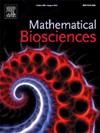Exploring the spatio–temporal dynamics in activator–inhibitor systems through a dual approach of analysis and computation
IF 1.8
4区 数学
Q2 BIOLOGY
引用次数: 0
Abstract
Real–world mathematical models often manifest as systems of non-linear differential equations, which presents challenges in obtaining closed-form analytical solutions. In this paper, we study the diffusion-driven instability of an activator–inhibitor–type reaction–diffusion (RD) system modeling the GEF–Rho–Myosin signaling pathway linked to cellular contractility. The mathematical model we study is formulated from first principles using experimental observations. The model formulation is based on the biological and mathematical assumptions. The novelty is the incorporation of Myo9b as a GAP for RhoA, leading to a new mathematical model that describes Rho activity dynamics linked to cell contraction dynamics. Assuming mass conservation of molecular species and adopting a quasi-steady state assumption based on biological observations, model reduction is undertaken and leads us to a system of two equations. We adopt a dual approach of mathematical analysis and numerical computations to study the spatiotemporal dynamics of the system. First, in absence of diffusion, we use a combination of phase-plane analysis, numerical bifurcation and simulations to characterize the temporal dynamics of the model. In the absence of spatial variations, we identified two sets of parameters where the model exhibit different transition dynamics. For some set of parameters, the model transitions from stable to oscillatory and back to stable, while for another set, the model dynamics transition from stable to bistable and back to stable dynamics. To study the effect of parameter variation on model solutions, we use partial rank correlation coefficient (PRCC) to characterize the sensitivity of the model steady states with respect to parameters. Second, we extend the analysis of the model by studying conditions under which a uniform steady state becomes unstable in the presence of spatial variations, in a process known as Turing diffusion–driven instability. By exploiting the necessary conditions for diffusion–driven instability and the sufficient conditions for pattern formation we carry out, numerically, parameter estimation through the use of mode isolation. To support theoretical and computational findings, we employ the pdepe solver in one-space dimension and the finite difference method in two–space dimension.

通过分析和计算的双重方法探索激活剂-抑制剂系统的时空动态
现实世界的数学模型通常表现为非线性微分方程系统,这对获得封闭形式的解析解提出了挑战。在本文中,我们研究了激活剂-抑制剂型反应-扩散(RD)系统的扩散驱动的不稳定性,该系统模拟了与细胞收缩性相关的GEF-Rho-Myosin信号通路。我们研究的数学模型是用实验观察从第一性原理推导出来的。模型的制定是基于生物学和数学假设。新颖之处在于Myo9b作为RhoA的GAP,导致了一个新的数学模型,该模型描述了与细胞收缩动力学相关的Rho活性动力学。假设分子物种的质量守恒,并采用基于生物学观察的准稳态假设,进行模型约简,得到一个由两个方程组成的系统。我们采用数学分析和数值计算的双重方法来研究系统的时空动力学。首先,在没有扩散的情况下,我们结合相平面分析、数值分岔和模拟来表征模型的时间动力学。在没有空间变化的情况下,我们确定了两组参数,其中模型表现出不同的过渡动态。对于某一组参数,模型从稳定过渡到振荡再回到稳定,而对于另一组参数,模型动力学从稳定过渡到双稳态再回到稳定动力学。为了研究参数变化对模型解的影响,我们使用偏秩相关系数(PRCC)来表征模型稳态对参数的敏感性。其次,我们通过研究在存在空间变化的情况下均匀稳态变得不稳定的条件来扩展模型的分析,这一过程被称为图灵扩散驱动的不稳定。通过利用扩散驱动不稳定性的必要条件和模式形成的充分条件,我们通过使用模式隔离在数值上进行参数估计。为了支持理论和计算结果,我们在一维空间中使用了pdepe求解器,在二维空间中使用了有限差分法。
本文章由计算机程序翻译,如有差异,请以英文原文为准。
求助全文
约1分钟内获得全文
求助全文
来源期刊

Mathematical Biosciences
生物-生物学
CiteScore
7.50
自引率
2.30%
发文量
67
审稿时长
18 days
期刊介绍:
Mathematical Biosciences publishes work providing new concepts or new understanding of biological systems using mathematical models, or methodological articles likely to find application to multiple biological systems. Papers are expected to present a major research finding of broad significance for the biological sciences, or mathematical biology. Mathematical Biosciences welcomes original research articles, letters, reviews and perspectives.
 求助内容:
求助内容: 应助结果提醒方式:
应助结果提醒方式:


